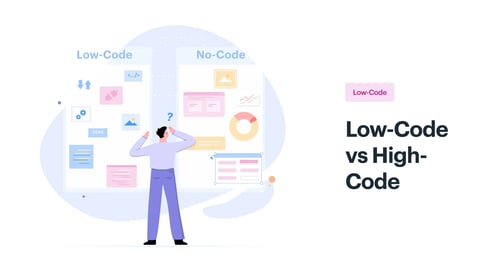
- >
- Low-Code Platform >
- Low-Code vs High-Code : Choosing the Best For App Development
Low-Code vs High-Code : Choosing the Best For App Development
Team Kissflow
Updated on 27 May 2025 • 5 min read
In the wake of the global pandemic, businesses have been compelled to fast-track their digital transformation efforts to cater to an expanding hybrid workforce. This has spurred a demand for robust, in-house business app development solutions that are not only effective and scalable but also foster collaboration and expedite delivery.
One pivotal decision that most businesses grapple with during this process is choosing between low-code and high-code approaches for building their own business applications. The optimal choice hinges on several factors, such as specific needs, projected development timeline, employee skill levels, and of course, budgetary constraints.
Let's delve deeper into the low-code versus high-code debate to better understand these two distinct methodologies.
.webp?width=260&height=260&name=Building%20Custom%20Enterprise%20apps%20(1).webp)
Building Custom Enterprise Applications on a Low-Code Platform
Thank you for downloading!
What is low-code?
Low-code application platform allow you to build applications even when you don’t have any in-depth expertise in coding.
According to Gartner, Inc.’s latest report, the global market for low-code development technologies is expected to be $26.9 billion in 2023 (an increase of 19.6 percent from 2022).
Instead of using complex programming languages, you can use drag and drop editors to build applications and processes. You can also take advantage of pre-built functionalities and reusable components to build applications quickly.
That means anyone in the organization can create applications with a low-code platform, even if they have limited technical expertise or abilities.
The benefits of using low-code solutions also include collaboration, speed, and customization.
For IT teams, low-code platforms help develop applications at a much faster speed and with fewer bugs as well.
This, in turn, helps accelerate digital transformation initiatives in organizations and saves on costs. In fact, 70 percent [1] of IT leaders agree that low-code platforms are more cost-effective than other traditional development solutions, including high-code.
A scenario where you need low-code
Consider a retail business that wants to quickly develop a mobile app for managing inventory across multiple store locations. The app needs to be user-friendly and have basic functionality like scanning barcodes, updating inventory counts, and sending alerts when stock is low.
Using a low-code platform, the business can quickly design and deploy this app. The drag-and-drop interfaces of low-code platforms make it easy to design a clean, intuitive user interface. Pre-built components for tasks like scanning barcodes or sending notifications can be easily integrated into the app. A low-code platform is a perfect fit since the app doesn't require complex functionality or high-level security protocols. It allows the business to rapidly develop and roll out its app without needing extensive coding knowledge.
What is high-code?
High-code refers to traditional programming where experienced developers are responsible for writing code and developing solutions from scratch. This approach is more code-driven as it is tightly tied to development cycles and controlled by developers.
The primary benefit of high code is that you can create custom business applications unique to your business.
However, high code also means heavy reliance on your IT team, which can end up excluding citizen developers and other business users. And with no way to include business users who will actually be using the application, it can be challenging to develop applications that completely fit the requirements of different teams and departments. Moreover, when everything requires the support of your IT department, including building and managing applications, it can take your talented developers away from more valuable work in the organization.
A scenario where you need High-Code
Now, imagine a financial technology startup that wants to develop a new mobile banking app. This app needs to offer features like money transfers, loan applications, investment services, and more. It also needs to integrate with existing banking systems, comply with financial regulations, and provide robust security to protect users' financial data.
In this case, a high-code approach would be more appropriate. While this approach requires more time and specialized coding knowledge, it offers the flexibility and control necessary to meet all the app's requirements. The developers can create custom algorithms for features like loan approval, ensure the app complies with all relevant regulations, and implement advanced security measures to protect user data. They can also optimize the app's performance to handle large volumes of transactions and integrate smoothly with other banking systems.
Low-code vs High-code – Quick comparison
|
|
Low-Code |
High-Code |
|
Coding Knowledge Required |
Minimal. Designed for users with various levels of technical expertise. |
Substantial. Requires deep understanding of coding languages. |
|
Development Speed |
Fast. Enables rapid prototyping and deployment of applications. |
Slow. Writing, testing, and debugging code can be time-consuming. |
|
Flexibility |
Limited. May not be suitable for highly complex or customized applications. |
High. Can handle complex and highly customized applications. |
|
Collaboration |
High. Facilitates collaboration between business users, developers, and IT professionals. |
Limited. Often requires specialized knowledge, which may limit collaboration. |
|
Vender Dependency |
High. Moving an app from one platform to another can be challenging. |
Low. Code can be more easily transferred between different systems. |
|
Maintenance and Updates |
Easier. Changes can be made quickly using the visual interface. |
More demanding. Requires coding knowledge and can be time-consuming. |
High-Code Drawbacks:
1. Requires substantial programming knowledge:
High-code development demands a deep understanding of coding languages, which can limit who can participate in the development process.
2. Time-consuming:
Developing software from scratch using high code can be a lengthy process as it involves writing, testing, and debugging lines of code.
3. Maintenance and updates:
High-code software typically requires more time and effort to maintain and update due to the complexity of the codebase.
Low-Code Drawbacks:
1. Limited flexibility:
While low-code platforms are excellent for creating general-purpose applications, they may lack the flexibility needed for highly customized or complex applications.
2. Dependency on vendors:
Since low-code platforms provide the infrastructure for app development, there can be concerns about vendor lock-in. Moving an app built on one low-code platform to another can be challenging.
3. Performance:
Applications built with low-code platforms can sometimes face performance issues when dealing with large volumes of data or complex tasks.
While both high-code and low-code have pros and cons, choosing between them depends on the project's specific needs, such as its complexity, budget, and timeline.
How low-code simplifies app building by creating a collaborative environment?
Low-code platforms are revolutionizing app development by enabling a collaborative environment that simplifies building applications. These platforms offer a visual development environment, which includes features like drag-and-drop functionality, allowing users to create software applications with minimal coding effort. This approach makes app development accessible to individuals with varying levels of technical expertise, from business users to professional developers.
The low-code factory approach allows for collaboration, innovation, and delivery among all stakeholders involved in the development process. This promotes quality and consistency at every step of the development cycle.
By simplifying coding and making app development more accessible, low-code platforms empower employees to create their own solutions, democratizing the app creation process. As a result, low-code development is seen as a revolution in app creation, enabling anyone to build their own mobile apps.
Digitize your workflows today using the Kissflow platform.
What to choose - Low Code vs High Code?High-code applications may seem like a great approach for building legacy applications. Still, in a world where technological trends change every few years, it can be incredibly expensive to build hard-coded monolithic applications from scratch and then find a way to scale and upgrade them every few years.
The answer to the low-code vs. high-code conundrum is simple – If you need a flexible business application development solution that can offer customization, quick turnaround, reusability, and affordability. At the same time, also including both technical and business users in the development process, low-code is the way to go.
"Low-code and no-code tools are a way to mitigate talent shortages because they allow companies to build software systems without the need for large teams of developers," says Amitha Pulijala, vice president of product, cloud platform services, CX, API, and AI at Vonage.
The CaratLane Success Story
CaratLane, India's largest online jewelry retailer, faced challenges with rapid growth and expanding operations. Ajith Singh, Head of Product Management, needed a solution to streamline operations without overburdening the IT team.
The company struggled with a lack of developer support, inefficient post-order processes, and accountability issues. Singh turned to Kissflow, a workflow automation platform, to address these issues. Using its no-code/low-code capabilities, Singh quickly developed applications for warehousing, quality checks, accounting, and customer service.
Kissflow led to increased customer satisfaction, reduced IT dependency, enhanced accountability, and enabled the speedy creation of custom apps. Since 2017, CaratLane has used Kissflow to manage its growth and operations effectively.
Explore the best low-code platforms for fast and flexible app development.
Kissflow - An Unified Work Platform
Kissflow low-code platform can help build custom business applications, automate processes, and digitize operations. Take a look to see how Kissflow can improve your organization’s productivity and efficiency while decreasing reliance on IT teams or consultants
Experience the power of low-code with the simplicity of no-code.
Related Articles











